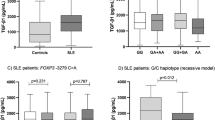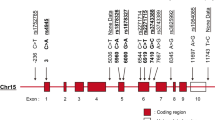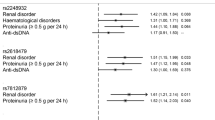Abstract
FasL expression is critical in T-cell activation-induced apoptosis, which is involved in lupus pathogenesis. This study identified two SNPs in the FasL promoter regions from –1145 to –45 by genomic DNA sequencing. The –844C/T polymorphism was previously described by its location in and affect on the CCAAT/enhancer-binding protein β (C/EBPB β)-binding site and the other (–1094A/C, a novel polymorphism) was located at the NF-κB transcription-binding site. FasL gene promoter polymorphisms were genotyped in 260 systemic lupus erythematosus (SLE) patients and 280 healthy controls using MassArray matrix-assisted laser desorption ionization-time-of-flight (MALDI-TOF) mass spectrometry. The distribution of FasL promoter –844C/C genotype, predominant in Taiwanese, was skewed in Taiwanese SLE patients (odds ratio: 1.53; P-value=0.014). FasL promoter −844C/T polymorphism genotype distributions of Taiwanese, African Americans, and Caucasians differed. Moreover, no particular clinical association of −844C/T and −1094A/C polymorphisms with SLE was found in patients in Taiwan. This study confirmed that −844C/C genotype is associated with lupus susceptibility. The –1094A/C polymorphism is not significantly associated with lupus disease susceptibility, albeit the role of NF-κB pathway in FasL promoter activation remains unclear. Fas/FasL pathway may contribute to SLE polygenic disease entity.
This is a preview of subscription content, access via your institution
Access options
Subscribe to this journal
Receive 6 digital issues and online access to articles
$119.00 per year
only $19.83 per issue
Buy this article
- Purchase on Springer Link
- Instant access to full article PDF
Prices may be subject to local taxes which are calculated during checkout
Similar content being viewed by others
References
Horwitz DA, Stohl W, Gray JD . T lymphocytes, natural killer cells and immune regulation. In: Wallace DJ, Hann BH (eds). In Dubois' Lupus Erythematosus. Lippincott Willams & Wilkins: Philadelphia, Pennsylvania, 2001, pp 155–185.
Strasser A, O'Connor L, Dixit VM et al. Apoptosis signaling. Annu Rev Biochem 2000; 69: 217–245.
Emlen W, Niebur J, Kadera R . Accelerated in vitro apoptosis of lymphocytes from patients with systemic lupus erthematosus. J Immunol 1994; 152: 3685–3692.
Silvestris F, Grinello D, Tucci M, Cafforio P, Dammacco F . Enhancement of T cell apoptosis correlates with increased serum levels of soluble Fas (CD95/Apo-1) in active lupus. Lupus 2003; 12: 8–14.
Grondal G, Traustadottir KH, Kristjansdottir H et al. Increased T-lymphocyte apoptosis/necrosis and IL-10 producing cells in patients and their spouses in Icelandic systemic lupus erythematosus multicase families. Lupus 2002; 11: 435–442.
Courtney PA, Crockard AD, Williamson K, Irvine AE, Kennedy RJ, Bell AL . Increased apoptotic peripheral blood neutrophils in systemic lupus erthematosus: relations with disease activity, antibodies to double stranded DNA, and neutrophia. Ann Rheum Dis 1999; 58: 309–314.
McConnell JR, Crockard AD, Cairns AP, Bell AL . Neutrophils from systemic lupus erythematosus patients demonstrate increased nuclear DNA damage. Clin Exp Rheumatol 2002; 20: 653–660.
Perniok A, Wedekind F, Heremann M, Specker C, Schneider M . High levels of circulating early apoptic peripheral blood mononuclear cells in systemic lupus erthematosus. Lupus 1998; 7: 113–118.
Ren Y, Tang J, Mok MY, Chan AW, Wu A, Lau CS . Increased apoptotic neutrophils and macrophages and impaired macrophage phagocytic clearance of apoptotic neutrophils in systemic lupus erythematosus. Arthritis Rheum 2003; 48: 2888–2897.
Shoshan Y, Shapira I, Toubi E, Frolkis I, Yaron M, Mevorach D . Accelerated Fas-mediated apoptosis of monocytes and maturing macrophages from patients with systemic lupus erythematosus: relevance to in vitro impairment of interaction with iC3b-opsonized apoptotic cells. J Immunol 2001; 167: 5963–5969.
Cairns AP, Crockard AD, McConnell JR, Courtney PA, Bell AL . Reduced expression of CD44 on monocytes and neutrophils in systemic lupus erythematosus: relations with apoptotic neutrophils and disease activity. Ann Rheum Dis 2001; 60: 950–955.
Herrmann M, Voll RE, Zoller OM, Hagenhoferr M, Ponner BB, Kalden JR . Impaired phagocytosis of apoptotic cells material by monocytes-derived macrophages from patients with systemic lupus erthematosus. Arthritis Rheum 1998; 41: 1241–1250.
Lee HO, Ferguson TA . Biology of FasL. Cytokine Growth Factor Rev 2003; 14: 325–335.
Cohen PL, Eisenberg RA . Lpr and gld: single gene models of systemic autoimmunity and lymphoproliferative disease. Annu Rev Immunol 1991; 9: 243–269.
Takahashi T, Tanaka M, Brannan CI et al. Generalized lymphoproliferative disease in mice caused by a point mutation in the Fas ligand. Cell 1994; 76: 969–976.
Rieux-Laucat F, Fischer A, Deist FL . Cell-death signaling and human disease. Curr Opin Immunol 2003; 15: 325–331.
Wang J, Zheng L, Lobito A et al. Inherited human caspase 10 mutations underlie defective lymphocyte and dendritic cell apoptosis in autoimmune lymphoproliferative syndrome type II. Cell 1999; 98: 47–58.
Drappa J, Vanishnaw AK, Sullivan KE, Chu JL, Elkon KB . The Canale Smith syndrome: an inherited autoimmune disorder associated with defective lympocyte apoptosis and mutations in the Fas gene. N Engl J Med 1996; 335: 1643–1649.
Vaishnaw AK, Toubi E, Ohsko S et al. The spectrum of apoptotic defects and clinical manifestations, including systemic lupus erthematosus, in human CD95 (Fas/APO-1) mutations. Arthritis Rheum 1999; 42: 1833–1842.
Kovacs B, Liossis SN, Dennis GJ, Tsokos GC . Increased expression of functional Fas-ligand in activated T cells from patients with systemic lupus erythematosus. Autoimmunity 1997; 25: 213–221.
McNally J, Yoo DH, Drappa J et al. Fas ligand expression and function in systemic lupus erythematosus. J Immunol 1997; 159: 4628–4636.
Eneslatt K, Rantapaa-Dahlqvist S, Uddhammar A, Sundqvist KG . The regulation of FasL expression—a distinguishing feature between monocytes and T lymphocytes/NK cells with possible implications for SLE. J Clin Immunol 2001; 21: 183–192.
Suzuki N, Ichino M, Mihara S, Kaneko S, Sakane T . Inhibition of Fas/Fas ligand-mediated apoptotic cell death of lymphocytes in vitro by circulating anti-Fas ligand autoantibodies in patients with systemic lupus erythematosus. Arthritis Rheum 1998; 41: 344–353.
Sakata K, Sakata A, Vela-Roch N et al. Fas (CD95)-transduced signal preferentially stimulates lupus peripheral T lymphocytes. Eur J Immunol 1998; 28: 2648–2660.
Courtney PA, Crockard AD, Williamson K, McConnell J, Kennedy RJ, Bell AL . Lymphocyte apoptosis in systemic lupus erythematosus: relationships with Fas expression, serum soluble Fas and disease activity. Lupus 1999; 8: 508–513.
Al-Maini MH, Mountz JD, Al-Mohri HA et al. Serum levels of soluble Fas correlate with indices of organ damage in systemic lupus erthematosus. Lupus 2000; 9: 132–139.
Wu J, Wilson J, He J, Xiang L, Schur PH, Mountz JD . Fas ligand mutation in a patient with systemic lupus erthematosus and lymphoproliferative disease. J Clin Invest 1996; 98: 1107–1113.
Kojima T, Horiuchi T, Nishizaka H et al. Analysis of Fas ligand gene mutation in patients with systemic lupus erthematosus. Arthritis Rheum 2000; 43: 135–139.
Takahashi T, Tanaka M, Inazawa J, Abe T, Suda T, Nagata S . Human Fas ligand: gene structure, chromosomal location and species specificity. Int Immunol 1994; 6: 1567–1574.
Li-Weber M, Krammer PH . Function and regulation of the CD95 (APO-1/Fas) ligand in the immune system. Semin Immunol 2003; 15: 145–157.
Wu J, Metz C, Xu X et al. A novel polymorphic CAAT/enhancer-binding protein beta element in the FasL gene promoter alters Fas ligand expression: a candidate background gene in African American systemic lupus erythematosus patients. J Immunol 2003; 170: 132–138.
White S, Rosen A . Apoptosis in systemic lupus erythematosus. Curr Opin Rheumatol 2003; 15: 557–562.
Salmon M, Gordon C . The role of apoptosis in systemic lupus erthematosus. Rheumatology 1999; 38: 1177–1183.
Siegel RM, Chan FK, Chun HJ, Lenardo MJ . The multifaceted role of Fas signaling in immune cell homeostasis and autoimmunity. Nat Immunol 2000; 1: 469–474.
Huizinga TW, Pisetsky DS, Kimberly RP . Associations, populations, and the truth: recommendations for genetic association studies in arthritis & rheumatism. Arthritis Rheum 2004; 50: 2066–2071.
Stuck BJ, Pani MA, Besrour F et al. No association of two Fas gene polymorphisms with Hashimoto's thyroiditis and Graves' disease. Eur J Endocrinol 2003; 149: 393–396.
Stuck BJ, Pani MA, Besrour F et al. Fas ligand gene polymorphisms are not associated with Hashimoto's thyroiditis and Graves' disease. Hum Immunol 2003; 64: 285–289.
Nolsoe RL, Kristiansen OP, Larsen ZM, Johannesen J, Pociot F, Mandrup-Poulsen T . Complete mutation scan of the human Fas ligand gene: linkage studies in Type I diabetes mellitus families. Diabetologia 2002; 45: 134–139.
Matsui K, Omura S, Cui H, Schauer SL, Sonenshein GE, Ju ST . Proteasome regulation of Fas ligand cytotoxicity. Eur J Immunol 1997; 27: 2269–2278.
Cui H, Matsui K, Omura S et al. Proteasome regulation of activation-induced T cell death. Proc Natl Acad Sci USA 1997; 94: 7515–7520.
Hsu SC, Gavrilin MA, Lee HH, Wu CC, Han SH, Lai MZ . NF-kappa B-dependent Fas ligand expression. Eur J Immunol 1999; 29: 2948–2956.
Holtz-Heppelmann CJ, Algeciras A, Badley AD, Paya CV . Transcriptional regulation of the human FasL promoter-enhancer region. J Biol Chem 1998; 273: 4416–4423.
Li-Weber M, Laur O, Dern K, Krammer PH . T cell activation-induced and HIV tat-enhanced CD95(APO-1/Fas) ligand transcription involves NF-kappaB. Eur J Immunol 2000; 30: 661–670.
Kasibhatla S, Genestier L, Green DR . Regulation of fas-ligand expression during activation-induced cell death in T lymphocytes via nuclear factor kappaB. J Biol Chem 1999; 274: 987–992.
Kasibhatla S, Brunner T, Genestier L, Echeverri F, Mahboubi A, Green DR . DNA damaging agents induce expression of Fas ligand and subsequent apoptosis in T lymphocytes via the activation of NF-kappa B and AP-1. Mol Cell 1998; 1: 543–551.
Acknowledgements
We thank Chang Gung Memorial Hospital for financially supporting this research under Grant No. CMRP 1255.
Author information
Authors and Affiliations
Corresponding author
Rights and permissions
About this article
Cite this article
Chen, JY., Wang, CM., Ma, CC. et al. The −844C/T polymorphism in the Fas ligand promoter associates with Taiwanese SLE. Genes Immun 6, 123–128 (2005). https://doi.org/10.1038/sj.gene.6364158
Received:
Revised:
Accepted:
Published:
Issue Date:
DOI: https://doi.org/10.1038/sj.gene.6364158
Keywords
This article is cited by
-
Apoptosis-related Fas and FasL gene polymorphisms’ associations with knee osteoarthritis
Rheumatology International (2013)
-
FAS and FAS Ligand Polymorphisms in the Promoter Regions and Risk of Gastric Cancer in Southern China
Biochemical Genetics (2009)
-
Dominant inhibition of Fas ligand-mediated apoptosis due to a heterozygous mutation associated with autoimmune lymphoproliferative syndrome (ALPS) Type Ib
BMC Medical Genetics (2007)
-
Disease association of the interleukin-18 promoter polymorphisms in Taiwan Chinese systemic lupus erythematosus patients
Genes & Immunity (2007)
-
Mutations in the NF-κB signaling pathway: implications for human disease
Oncogene (2006)



